
Naxxar is a small city in the Northern Region of Malta, with a population of 14,891 people as of March 2014. The Naxxar Church is dedicated to Our Lady of Victories. The annual village feast is celebrated on 8 September. Naxxar was formerly known for hosting the Maltese International Trade Fair at Maltese International Trade Fair Grounds.

Saint Mark's Tower, originally known as Torre del Cortin and also known as Qalet Marku Tower, is a small watchtower in Baħar iċ-Ċagħaq, limits of Naxxar, Malta. It was completed in 1658 as the third of the De Redin towers. Today, the tower is in good condition.

Madliena Tower, originally known as Torre della Paulina, is a small watchtower in Madliena, limits of Pembroke, Malta. It was completed in 1658 as the fourth of the De Redin towers. The British built an artillery battery next to the tower in 1908–1909, and the tower and battery remained in use until World War II. Today, the battery no longer exists but the tower is in good condition.

The fortifications of Malta consist of a number of walled cities, citadels, forts, towers, batteries, redoubts, entrenchments and pillboxes. The fortifications were built over hundreds of years, from around 1450 BC to the mid-20th century, and they are a result of the Maltese islands' strategic position and natural harbours, which have made them very desirable for various powers.

Vendôme Tower is a tour-reduit in Marsaxlokk, Malta. It was built by the Order of Saint John in 1715 as one of a series of coastal fortifications around the coasts of the Maltese Islands. It is the only surviving tour-reduit in Malta. Today, Vendôme Tower houses the headquarters of Marsaxlokk F.C.

The fortifications of Valletta are a series of defensive walls and other fortifications which surround Valletta, the capital city of Malta. The first fortification to be built was Fort Saint Elmo in 1552, but the fortifications of the city proper began to be built in 1566 when it was founded by Grand Master Jean de Valette. Modifications were made throughout the following centuries, with the last major addition being Fort Lascaris which was completed in 1856. Most of the fortifications remain largely intact today.
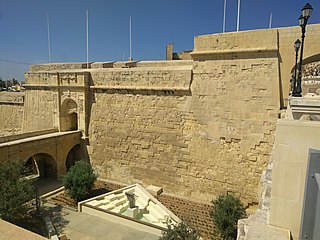
The fortifications of Birgu are a series of defensive walls and other fortifications which surround the city of Birgu, Malta. The first fortification to be built was Fort Saint Angelo in the Middle Ages, and the majority of the fortifications were built between the 16th and 18th centuries by the Order of Saint John. Most of the fortifications remain largely intact today.

The fortifications of Senglea are a series of defensive walls and other fortifications which surround the city of Senglea, Malta. The first fortification to be built was Fort Saint Michael in 1552, and the majority of the fortifications were built over the next decade when it was founded by Grand Master Claude de la Sengle. Modifications continued until the 18th century, but large parts of the fortifications were demolished between the 19th and 20th centuries. Today, all that remain of Senglea's fortifications are the seaward bastions and part of the land front.
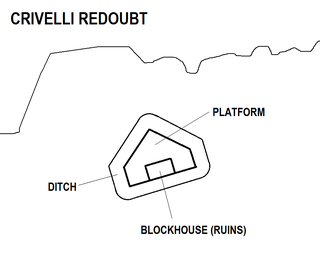
Crivelli Redoubt, also known as Barriera Redoubt or Armier Redoubt, is a redoubt in Armier Bay, Mellieħa, Malta. It was built by the Order of Saint John in 1715–1716 as part of a series of coastal fortifications around the Maltese Islands. Today, the redoubt is in good condition.

Tal-Bir Redoubt, also known as Wied Musa Redoubt, is a redoubt in the limits of Mellieħa, Malta. It was built by the Order of Saint John in 1715–1716 as one of a series of coastal fortifications around the Maltese Islands. Today, the redoubt lies in ruins.

Qalet Marku Battery, also known as D'Orbeau Battery, was an artillery battery in Baħar iċ-Ċagħaq, limits of Naxxar, Malta. It was built in 1715–1716 by the Order of Saint John as one of a series of coastal fortifications around the Maltese Islands. The battery has been largely destroyed, but some remains can still be seen.
Għallis Battery, also known as Pondéves Battery, was an artillery battery in Magħtab, limits of Naxxar, Malta. It was built in 1715–1716 by the Order of Saint John as one of a series of coastal fortifications around the Maltese Islands. The battery has been mostly ruined, but some debris can still be seen.
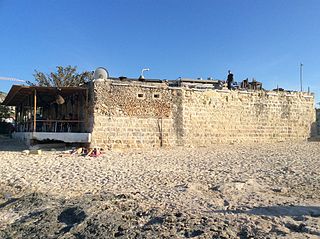
Baħar iċ-Ċagħaq Redoubt is a redoubt in Baħar iċ-Ċagħaq, limits of Naxxar, Malta. It was built in 1715–1716 by the Order of Saint John as one of a series of coastal fortifications around the Maltese Islands. Today, the redoubt still exists and is in relatively good condition.
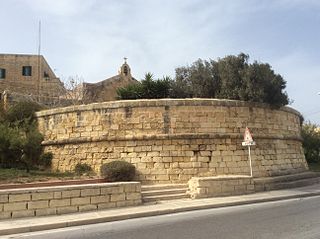
Saint George Redoubt is a redoubt in Birżebbuġa, Malta. It was built in 1714–1716 by the Order of Saint John as one of a series of coastal fortifications around the Maltese Islands, and it got its name from a chapel dedicated to St. George which was incorporated within the redoubt. Today, the redoubt and chapel still exist and they are in good condition.

Briconet Redoubt, also known as Marsaskala Redoubt or the Vendôme Entrenchment, is a redoubt in Marsaskala, Malta. It was built in 1715 by the Order of Saint John as one of a series of coastal fortifications around the Maltese Islands. Until recently, the redoubt was used as a police station.

Cavalier Tower, also known as Qrendi Tower or Captain's Tower, and previously as Ellul Preziosi Tower, is a tower in the town of Qrendi, Malta. It was built in the late medieval or early Hospitaller period, and it is one of the oldest surviving towers in Malta.
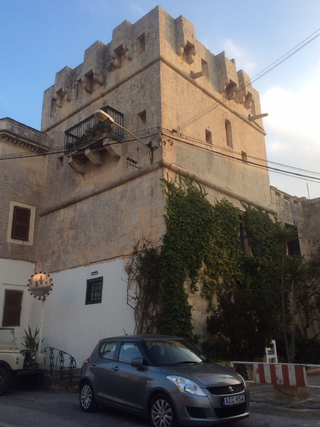
Gauci Tower is a tower in Naxxar, Malta. It was built before 1548 by the Gauci family. Today, the tower is in good condition.

The Naxxar Entrenchment is an infantry entrenchment in Naxxar, Malta, which was built in the 18th century by the Order of Saint John. Today, it lies in ruins but is still the best preserved inland entrenchment in Malta. It is a list monument of the NICPMI.

Hompesch Hunting Lodge, also known as Id-Dar tal-Kaċċa, is an 18th-century hunting lodge in Naxxar, Malta. It is a traditional Maltese historic building with a vernacular architecture. The hunting lodge was built intentionally to be used as a hunting lodge for the Grand Master of the Order of St. John, namely Grand Master Ferdinand von Hompesch zu Bolheim. Today the building is in a dilapidated state.

Ta' Cisju Farmhouse is an 18th-century farmhouse in Naxxar, Malta. The farmhouse was built in 1730 in an area known as Ħal Muselmiet, during the rule of the Order of St. John. According to the Naxxar Local Council, the building is the oldest farmhouse in the area of its type. The farmhouse has a vernacular structure with traditional Maltese architecture. The farmhouse was used for agricultural purposes but it is now a residential building.


















